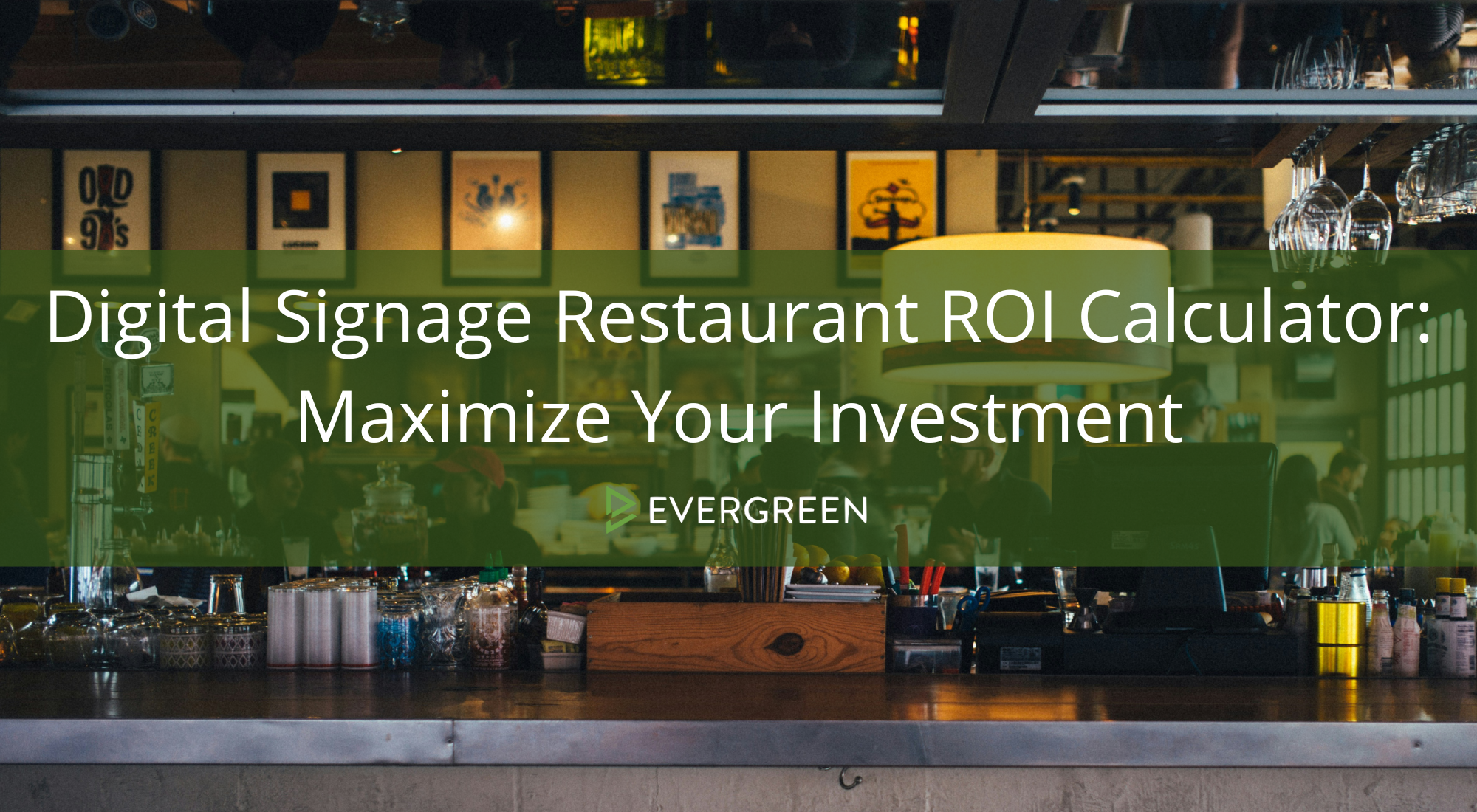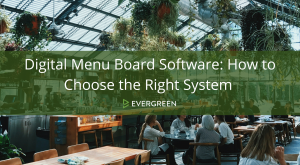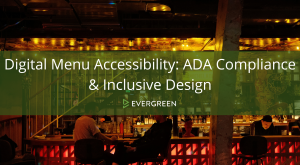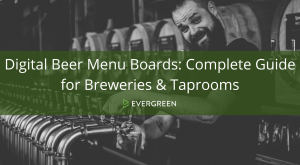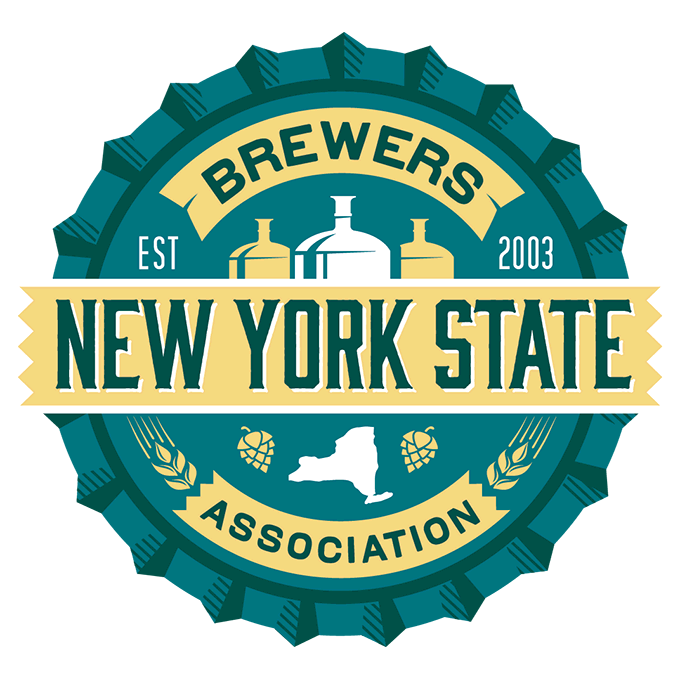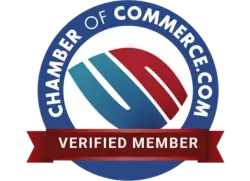Digital signage has evolved from a luxury to a necessity for competitive restaurants, but calculating the return on investment (ROI) requires understanding both direct and indirect benefits. Restaurants implementing comprehensive digital signage strategies report average ROI of 312%, with top performers achieving returns exceeding 500%.
This detailed ROI calculator and analysis guide helps restaurant owners make data-driven decisions about digital signage investments, including hidden costs, implementation strategies, and optimization techniques for maximum return.
Understanding Digital Signage ROI Components
Direct Revenue Impact Factors
Increased Average Order Value (AOV):
Digital signage strategically influences customer purchasing decisions through psychological triggers and upselling techniques:
Visual Menu Psychology: Well-designed digital menus increase AOV by 18-35%
Strategic Item Placement: Premium items in visual “hot spots” see 41% higher selection rates
Dynamic Pricing: Time-based pricing optimization increases revenue by 12-28%
Cross-Selling Integration: Automated pairing suggestions boost add-on sales by 23-45%
Limited-Time Offers: Scarcity messaging drives impulse purchases up 34%
Customer Traffic Enhancement:
Digital signage attracts new customers and increases visit frequency:
Street Appeal: Eye-catching digital displays increase foot traffic by 15-30%
Social Media Integration: Interactive displays boost social sharing by 156%
Event Promotion: Dynamic event advertising increases event attendance by 67%
Weather-Responsive Content: Adaptive messaging drives traffic during slow periods by 23%
Brand Differentiation: Modern appearance attracts tech-savvy demographics by 45%
Operational Cost Savings
Labor Efficiency Improvements:
Digital signage reduces staff time and improves operational efficiency:
Menu Update Time: Eliminates 2-4 hours weekly of manual menu updates
Customer Service: 67% reduction in menu-related questions and explanations
Order Accuracy: Digital clarity reduces order mistakes by 34%
Staff Training: Consistent information reduces new employee training time by 45%
Promotional Management: Automated scheduling eliminates manual promotional changes
Material Cost Elimination:
Digital displays replace traditional printed materials:
Menu Printing: Average savings of $200-800 monthly depending on restaurant size
Promotional Materials: Elimination of poster and flyer printing costs
Seasonal Updates: No reprinting costs for seasonal menu changes
Special Event Signage: Dynamic event promotion without printing expenses
Damage Replacement: Digital content never gets damaged or stolen
The Complete ROI Calculation Framework
Initial Investment Calculation
Hardware Costs:
Understanding upfront investment requirements:
Basic Setup (Small Restaurant – 3 screens):
43″ Commercial Displays: $600 each × 3 = $1,800
Media Players (Roku Ultra): $150 each × 3 = $450
Mounting Hardware: $100 each × 3 = $300
Installation: $200 each × 3 = $600
Total Hardware: $3,150
Professional Setup (Medium Restaurant – 6 screens):
55″ Commercial Displays: $1,200 each × 6 = $7,200
Commercial Media Players: $400 each × 6 = $2,400
Professional Mounting: $250 each × 6 = $1,500
Professional Installation: $400 each × 6 = $2,400
Network Upgrades: $1,000
Total Hardware: $14,500
Enterprise Setup (Large Restaurant – 12 screens):
65″ Ultra-HD Displays: $2,000 each × 12 = $24,000
Enterprise Media Players: $800 each × 12 = $9,600
Custom Mounting Solutions: $500 each × 12 = $6,000
Professional Installation & Network: $8,000
Content Management System: $5,000
Total Hardware: $52,600
Software and Service Costs:
Monthly and annual recurring expenses:
Entry-Level Software:
Monthly Subscription: $50-200/month
Setup and Onboarding: $500-2,000
Training: $500-1,500
Annual Software Cost: $1,600-4,900
Professional Software:
Monthly Subscription: $200-800/month
Setup and Integration: $2,000-8,000
Training and Support: $1,500-5,000
Annual Software Cost: $6,900-19,600
Enterprise Platform:
Monthly Subscription: $800-2,500/month
Custom Setup: $10,000-50,000
Comprehensive Training: $5,000-20,000
Annual Software Cost: $24,600-80,000
Revenue Enhancement Calculations
Average Order Value Increase:
Baseline Scenario (Conservative):
Current AOV: $25
Digital Signage AOV Increase: 18%
New AOV: $29.50
Additional Revenue per Customer: $4.50
Optimized Scenario (Aggressive):
Current AOV: $25
Digital Signage AOV Increase: 35%
New AOV: $33.75
Additional Revenue per Customer: $8.75
Traffic Volume Impact:
Small Restaurant (100 customers/day):
Conservative Traffic Increase: 15%
New Daily Customers: 115
Additional Monthly Revenue: $4.50 × 115 × 30 = $15,525
Medium Restaurant (250 customers/day):
Moderate Traffic Increase: 25%
New Daily Customers: 313
Additional Monthly Revenue: $6.50 × 313 × 30 = $61,035
Large Restaurant (500 customers/day):
Aggressive Traffic Increase: 30%
New Daily Customers: 650
Additional Monthly Revenue: $8.75 × 650 × 30 = $171,125
Cost Savings Calculations
Labor Savings:
Quantifying operational efficiency improvements:
Menu Management Time Savings:
Previous weekly menu update time: 4 hours
New digital update time: 30 minutes
Time savings: 3.5 hours weekly
Hourly labor cost: $15/hour
Weekly savings: $52.50
Annual savings: $2,730
Customer Service Efficiency:
Reduced menu explanation time: 2 minutes per customer
Daily customer interactions reduced: 50
Daily time savings: 100 minutes
Hourly labor cost: $15/hour
Daily savings: $25
Annual savings: $9,125
Printing and Material Costs:
Elimination of traditional printed materials:
Small Restaurant:
Monthly menu printing: $150
Promotional materials: $100
Special event signage: $75
Monthly savings: $325
Annual savings: $3,900
Medium Restaurant:
Monthly menu printing: $400
Promotional materials: $250
Special event signage: $150
Seasonal updates: $200
Monthly savings: $1,000
Annual savings: $12,000
Large Restaurant:
Monthly menu printing: $800
Promotional materials: $500
Special event signage: $300
Seasonal updates: $400
Multi-location coordination: $300
Monthly savings: $2,300
Annual savings: $27,600
ROI Calculation Examples by Restaurant Type
Small Independent Restaurant ROI Analysis
Restaurant Profile:
Daily customers: 100
Average order value: $22
Annual revenue: $803,000
Staff: 8 employees
Investment Costs:
Hardware: $3,150
Software (Year 1): $2,400
Implementation: $1,000
Total Year 1 Investment: $6,550
Annual Benefits:
AOV increase (20%): $32,120
Traffic increase (15%): $27,105
Labor savings: $6,855
Material savings: $3,900
Total Annual Benefits: $69,980
ROI Calculation:
Net Benefit: $69,980 – $6,550 = $63,430
ROI Percentage: ($63,430 ÷ $6,550) × 100 = 968%
Payback Period: 1.3 months
Mid-Size Restaurant Chain ROI Analysis
Restaurant Profile:
3 locations
Daily customers per location: 200
Average order value: $28
Annual revenue per location: $2,044,000
Total chain revenue: $6,132,000
Investment Costs:
Hardware (3 locations): $21,900
Software (Year 1): $12,000
Implementation and Training: $8,000
Total Year 1 Investment: $41,900
Annual Benefits:
AOV increase (25%): $383,100
Traffic increase (22%): $336,312
Labor savings (3 locations): $35,565
Material savings (3 locations): $36,000
Cross-location efficiency: $25,000
Total Annual Benefits: $815,977
ROI Calculation:
Net Benefit: $815,977 – $41,900 = $774,077
ROI Percentage: ($774,077 ÷ $41,900) × 100 = 1,848%
Payback Period: 0.6 months
Large Restaurant Enterprise ROI Analysis
Restaurant Profile:
15 locations
Daily customers per location: 400
Average order value: $35
Annual revenue per location: $5,110,000
Total enterprise revenue: $76,650,000
Investment Costs:
Hardware (15 locations): $217,500
Enterprise Software (Year 1): $60,000
Implementation and Training: $45,000
Total Year 1 Investment: $322,500
Annual Benefits:
AOV increase (30%): $6,898,500
Traffic increase (28%): $5,984,760
Labor savings (15 locations): $273,750
Material savings (15 locations): $414,000
Enterprise efficiency gains: $500,000
Brand consistency value: $300,000
Total Annual Benefits: $14,371,010
ROI Calculation:
Net Benefit: $14,371,010 – $322,500 = $14,048,510
ROI Percentage: ($14,048,510 ÷ $322,500) × 100 = 4,356%
Payback Period: 0.3 months
Advanced ROI Optimization Strategies
Dynamic Pricing Implementation
Time-Based Pricing Optimization:
Implementing demand-based pricing through digital signage:
Happy Hour Optimization:
Increase prices 10-15% during peak demand
Decrease prices 15-25% during slow periods
Average revenue increase: 12-18%
Implementation requirement: Advanced software with POS integration
Weather-Responsive Pricing:
Cold weather: Promote hot beverages and comfort food at premium pricing
Hot weather: Feature cold drinks and light meals
Rainy days: Extended happy hour pricing to retain customers
Average revenue increase: 8-15%
Event-Based Dynamic Pricing:
Sports events: Premium pricing for popular items during games
Holidays: Special pricing for themed menus and seasonal items
Local events: Adjusted pricing based on increased demand
Average revenue increase: 15-25%
Customer Behavior Analytics Integration
Data-Driven Menu Optimization:
Using digital signage analytics to optimize menu performance:
Heat Map Analysis:
Track which menu items receive most visual attention
Optimize placement of high-margin items in attention zones
A/B test different menu layouts for performance
Average revenue increase: 10-20%
Conversion Rate Optimization:
Monitor viewing time vs. purchase decisions
Optimize content timing and rotation frequency
Adjust description length and visual elements
Average conversion improvement: 15-30%
Customer Segmentation:
Analyze behavior patterns by customer demographics
Customize content for different time periods and customer types
Implement personalized recommendations where possible
Average revenue increase: 20-35%
Multi-Location Synergies
Centralized Management Benefits:
Leveraging scale for improved ROI across multiple locations:
Content Creation Efficiency:
Single content creation for multiple locations
Reduced per-location content costs by 60-80%
Consistent brand messaging and promotion
Economies of scale in design and photography
Performance Benchmarking:
Cross-location performance comparison
Best practice sharing and implementation
Rapid testing and rollout of successful strategies
Average performance improvement: 25-40%
Supply Chain Integration:
Coordinated promotions based on bulk purchasing
Real-time inventory sharing and optimization
Reduced waste through demand forecasting
Average cost savings: 15-25%
Technology Integration ROI Enhancement
POS System Integration Benefits
Real-Time Inventory Management:
Automatic menu updates based on inventory levels
Elimination of disappointed customers and lost sales
Optimized pricing based on supply and demand
Average revenue protection: 5-12%
Sales Data Integration:
Real-time performance tracking and optimization
Automated upselling based on sales patterns
Dynamic promotion of underperforming items
Average revenue increase: 8-18%
Social Media Integration Value
User-Generated Content Display:
Customer photos and reviews displayed in real-time
Increased social media engagement and sharing
Enhanced brand authenticity and trust
Average traffic increase: 12-25%
Viral Marketing Amplification:
Hashtag campaigns and social media contests
Influencer content integration and promotion
Community engagement and local market penetration
Average brand awareness increase: 30-60%
Mobile App Integration
Loyalty Program Enhancement:
Digital loyalty card display and management
Personalized offers and rewards promotion
Gamification elements and achievement displays
Average customer retention increase: 20-35%
Pre-Ordering Integration:
Mobile order display and pickup coordination
Reduced wait times and improved customer satisfaction
Increased order accuracy and customer convenience
Average efficiency improvement: 25-40%
ROI Measurement and Tracking
Key Performance Indicators (KPIs)
Revenue Metrics:
Average order value trends
Customer traffic patterns
Sales per square foot
Revenue per customer
Profit margin improvements
Operational Metrics:
Order accuracy rates
Service speed improvements
Staff productivity measures
Customer satisfaction scores
Social media engagement rates
Cost Metrics:
Labor cost per customer
Material and printing savings
Energy consumption (LED vs. traditional)
Maintenance and replacement costs
Training and support costs
Tracking Implementation
Monthly Review Process:
Revenue comparison (pre vs. post implementation)
Cost analysis and savings verification
Customer feedback and satisfaction measurement
Staff feedback and operational efficiency assessment
Technology performance and reliability monitoring
Quarterly Optimization:
Content performance analysis and optimization
Pricing strategy review and adjustment
Integration enhancement and feature utilization
Competitive analysis and market positioning
ROI calculation and projection updates
Annual Strategic Assessment:
Comprehensive ROI analysis and reporting
Technology upgrade and expansion planning
Market trend analysis and adaptation
Long-term strategy development and refinement
Budget planning and resource allocation
Common ROI Pitfalls and How to Avoid Them
Implementation Mistakes
Underestimating Total Costs:
Hidden costs: Network upgrades, mounting, installation
Ongoing costs: Content creation, maintenance, support
Opportunity costs: Staff time, learning curve, disruption
Solution: Comprehensive cost analysis including all factors
Overestimating Immediate Impact:
Customer adaptation period required for behavioral change
Staff learning curve affecting operational efficiency
Content optimization time needed for maximum impact
Solution: Realistic timeline with gradual improvement expectations
Content and Strategy Issues
Poor Content Quality:
Unprofessional design reducing brand perception
Outdated or inaccurate information damaging credibility
Overwhelming content causing decision paralysis
Solution: Professional content creation and regular updates
Lack of Strategic Focus:
Technology focus over customer experience focus
Feature complexity over business objective clarity
Short-term thinking over long-term strategy development
Solution: Clear business objectives and customer-centric approach
Measurement and Optimization Failures
Inadequate Tracking:
Missing baseline measurements for comparison
Inconsistent data collection and analysis
Attribution challenges for revenue improvements
Solution: Comprehensive tracking system from day one
Static Implementation:
Set-and-forget mentality without optimization
Lack of A/B testing and continuous improvement
Ignoring customer feedback and market changes
Solution: Continuous optimization and improvement process
Future ROI Considerations
Technology Evolution Impact
Artificial Intelligence Integration:
Automated content optimization increasing ROI by 25-50%
Predictive analytics improving inventory and pricing decisions
Personalized customer experiences driving loyalty and spending
Investment horizon: 2-3 years for full AI implementation
Advanced Analytics:
Customer behavior prediction and optimization
Real-time performance monitoring and adjustment
Competitive analysis and market positioning intelligence
Expected ROI improvement: 30-75% over current levels
Market Trend Adaptation
Sustainability Focus:
Energy-efficient displays reducing operational costs
Paperless operations enhancing environmental brand positioning
Waste reduction through demand forecasting and inventory optimization
Long-term cost savings: 15-30% operational cost reduction
Changing Consumer Expectations:
Digital-first customer experiences becoming standard
Personalization and customization demand increasing
Social media integration becoming essential for engagement
Competitive necessity: Digital signage as baseline requirement
Maximizing Your Digital Signage Investment
Digital signage ROI calculation requires comprehensive analysis of both direct revenue impact and operational efficiency improvements. The restaurants achieving 500%+ ROI implement strategic, customer-focused approaches with continuous optimization and measurement.
Key Success Factors:
Comprehensive Cost Analysis: Understanding total investment including hidden and ongoing costs
Realistic Timeline: Allowing adequate time for customer adaptation and content optimization
Strategic Integration: Connecting digital signage with broader business objectives and systems
Continuous Optimization: Regular measurement, testing, and improvement of content and strategy
Customer Focus: Prioritizing customer experience over technology showcase
The Path to Maximum ROI:
Start with Clear Objectives: Define specific business goals and success metrics
Invest in Quality: Professional implementation and content creation pay long-term dividends
Measure Everything: Comprehensive tracking enables optimization and demonstrates value
Optimize Continuously: Regular testing and improvement maximize performance over time
Think Long-Term: Strategic approach builds sustainable competitive advantage
The investment in digital signage technology, when implemented strategically and optimized continuously, delivers measurable returns that far exceed the initial investment. The key is understanding that ROI comes not from the technology itself, but from how effectively that technology enhances customer experience, improves operational efficiency, and drives business growth.
With proper planning, implementation, and optimization, digital signage ROI of 300-500% is not just possible—it’s predictable and sustainable for restaurants committed to strategic technology investment and continuous improvement.

